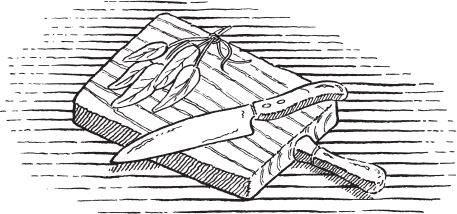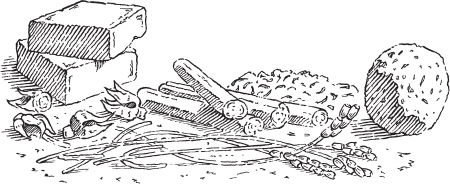
Полная версия:
The Real Witches’ Kitchen: Spells, recipes, oils, lotions and potions from the Witches’ Hearth

These steps can be formal and elaborate, as in group working, or very simple and performed using visualization when working on your own.
Any Craft-related action done within the Sacred Space will have more effect and potency than the same action performed outside the Sacred Space. Having said that, in most cases things can be made outside the Circle and then taken into it and blessed or consecrated for use. Alternatively, you can Magically enhance your remedies whilst making them and empower them for use.
Magically Enhancing and Empowering your Work
To Enhance Work in Preparation
Whether you are making a healing potion or bathing in preparation for a Magical working, the first step is to clear your mind of all distractions so that you can fully focus on your intent, for it is intent and focus which make the Magic work. One of the keys to this is to carefully prepare your working area. Make sure it is clean and tidy before you start, for physical distractions lead to mental ones.
You also have to carefully define your needs and goals. Make sure that you know what you intend to do and why. Are your motives pure? Having formulated your desire, you then need to assemble all your ingredients, checking that you have everything you need and finding substitutes where necessary. Then you can commence work.
Whilst working, you need to keep your goals firmly in mind, if necessary by writing them out and keeping a copy in front of you. You should also try to summon from within yourself the elements, in terms of thinking about what you are doing (Air), empowering it with enthusiasm (Fire) and emotion (Water), by the actual work (Earth) and by focusing your intent (Spirit). If you can, dedicate the work to a particular Goddess(es) and/or God(s), as you will find that they will lend their aid not only to your Magic, but also to making the physical side of things proceed more easily.
To Magically Empower a Product
There are many ways of empowering a potion or object, from simply placing it in the light of the Full Moon overnight to a full Ritual of Consecration (see below). However, you cannot sit food on the windowsill overnight for consumption the following day! Instead you might like to dedicate it to your chosen deity or deities. To do this, create a small clear space around your chosen item or product and visualize each of the elements in turn. See them in your mind’s eye materializing over the product and then enhancing it with their energy. Then take up the item in your hands and call (either out loud, or in your mind) upon the Goddess and the God to lend their power to your intent. Visualize them reaching out and touching the item and blessing it. When you feel that this is complete, thank the Goddess and the God, and each of the elements, for their aid.
If you prefer a more formal approach, and you are creating something which does not have to be consumed immediately, then you can consecrate it ritually. This will involve setting an Altar and casting a Circle by invoking the elements of Air, Fire, Water and Earth, and inviting the Goddess and the God. After this, pass the object through the incense smoke and candle flame, then sprinkle it with water and salt whilst naming it and its purpose, and asking for their energy to enhance it. Next, you present it to the Goddess and the God and ask their blessing in the way described above. Lastly, you will need to remove the Circle and clear away your working space by thanking and banishing the elements and the Divine.

Disposing of your Spell
People often ask me how to dispose of spells, charms, sachets, and so on once they have fulfilled their purpose or the Magic is no longer required.
The first thing to do is to remember to give thanks to the Goddess and the God. It is not enough to just accept the Magic, you need to try to give back something too. Perhaps plant a useful herb in your garden or, if you have the space, a tree dedicated to the Gods. Alternatively, spend some time working on the land or clearing rubbish from your local park.
After you have given something back, then it is time to dispose of the sachet. Open it and scatter all the environmentally-friendly parts to the winds. Stones, crystals and charms should be buried or cast into the sea or a stream. The fabric of the sachet and any paper, perhaps with your intent written on, can be burned or torn into shreds and buried.

Keeping a Journal or Book of Shadows
In the Craft we often recommend that each Witch keeps their own Book of Shadows, so called because it is but a shadow of reality. In this they record their Magical workings and experiences, as well as their thoughts and feelings about the Craft. They use it to monitor their own progress and as a record for their future reference. In a Coven, the High Priestess may also ask to see this journal so that she may monitor the progress of those Witches in her care as well as help to guide their future development.
In herbal work it really is essential to keep a record of what you have done, how much of each ingredient you used, when and how you made it (including the phase of the Moon), when and how it was used, and the results. How else are you going to be able to monitor your progress and the efficacy of your products?
Whether you keep a formal Book of Shadows or a simple ‘cookery’ journal, it is important that you keep it safe from prying eyes, as even the thought that someone may be reading your thoughts is usually enough to stop you from recording them honestly (see here).
I would advise that starting such a journal is perhaps your first step on the road towards becoming a ‘Kitchen Witch’.

Guidelines for Buying, Using and Storing Herbs and Plants
‘Whenever ye have need of any thing…’

Many of the recipes in this book involve the use of herbs and plants whose uses and effects you may be unfamiliar with. So here are some guidelines to help you to use them safely and efficiently.














Although the above instructions may look quite daunting at first glance, they are in fact the day-to-day practical precautions which we should take with anything we are going to consume or use on our bodies.
Working sensibly with herbs and plants is very rewarding, not only because of the cures that can be effected, but also because of the knowledge that we are in a position to help ourselves and those we care for. In addition, it is great fun.
Soaps and Bathing Preparations
‘A proper person, properly prepared…’

An important part of any ritual is preparation, whether that be a Magical ritual or a daily one. For most people, a night out is preceded by a ritual of washing the body and hair, and often applying scents to set the mood. Whilst doing so they think about where they are going, what they will be doing and what they hope will happen. It is no different in the Craft; wherever possible we wash our bodies, or at least our hands, to remove not only the dirt of the day, but also the negative thoughts and feelings of day-to-day life. At the same time we also prepare our minds by thinking through what we are about to do and what we wish to achieve. Of course, this can be done with plain soaps and bathing products, but it can be greatly enhanced by the use of products which we have created, altered and Magically empowered. Here I am going to take a look at ways of creating or, more often, changing existing products to Magically enhance them.
Whilst it is possible to make soaps, bath foams, shampoos and anointing oils from first principles, it is not really practical for everyone. As a result I am going to talk mainly about how we can take existing products and change them for our purposes.
The use of such enhanced products does not have to be limited to preparation for ritual. Keeping a bar of healing or refreshing soap in the bathroom can help us through daily life. Preparing a bath foam to help encourage sleep can be invaluable for the parent of a young child who refuses to ‘go down’ at night. So, many of the following will not be set aside for Craft work, but will have a place in daily life.
Abbreviations
lb

oz

fl oz

tbsp

(note this is not the same as a serving spoon), should be around 15 fl oz tsp teaspoonful, around 1/4 fl oz
Soaps
The basic ingredients for soap are in fact quite caustic, so it is not only easier but also more user-friendly to rework ready-made soap. The best kind to choose is a pure, unscented castille soap, although you can use this method with other kinds of unscented soaps.
First cut up (or grate) about 4 oz (1 cup) of the soap and place in a heatproof non-metallic container.








The soaps can then be used or wrapped in cheesecloth and kept or given away. As an aside, ordinary soap will always last longer if you take it out of its wrapper and keep it in a warm dry place to get completely hard before use.
All the following recipes are based on the above quantity of soap. As people relate to different scents in different ways, these can be adjusted according to your own preferences. Additionally, you can adapt any of the following to a plain unscented liquid soap, but do be aware that liquid soaps are usually detergent-based and hence not really very good for the skin. Where it says ‘oil’ in the following recipes I refer to essential oil, except in the case of the coconut oil in the dry skin recipe. When using herbs or other dried ingredients, make sure that you remove the really hard woody bits to make the soap pleasant to use. If you do not like textured or ‘gritty’ soap, then substitute drops of the appropriate oils.
It is worth noting that when using soap you should always lather it in your hands and then wash the rest of yourself with the lather. It is not a good idea to rub any soap directly onto other areas of the skin as it can be too harsh and drying.
Mental and Physical Cleansing
This is excellent for use before any ritual, or indeed any time when you need to mark the division between one part of your day and another, for example the transition from your work self to your home self.
1 tbsp lavender flowers
6 drops frankincense oil
6 drops sandalwood oil
4 drops jasmine oil
Esbat Soap
This takes the cleansing recipe a step further in that it is designed to prepare you for the working element of ritual and Magic, when you will need the additional ability to focus and control.
1 tbsp rosemary leaves
1/2 tsp ground cinnamon
6 drops frankincense oil
6 drops sandalwood oil
4 drops jasmine oil
4 drops oil of orange
(you can literally scrape the oil from the outside of an orange using a blunt knife)
Sabbat Soap
The Sabbats are less a time of working and more a time of celebration, hence a different blend. Of course you could make different soaps for different Sabbats, altering the ingredients to match the key points of the festival and the season, in which case you might wish to make a smaller quantity of soap and use it on a daily basis for the seven days prior to the Sabbat, in preparation for it.
1 tbsp rosemary leaves
1/2 tbsp jasmine flowers
6 drops sandalwood oil
6 drops frankincense oil
3 drops cinnamon oil



